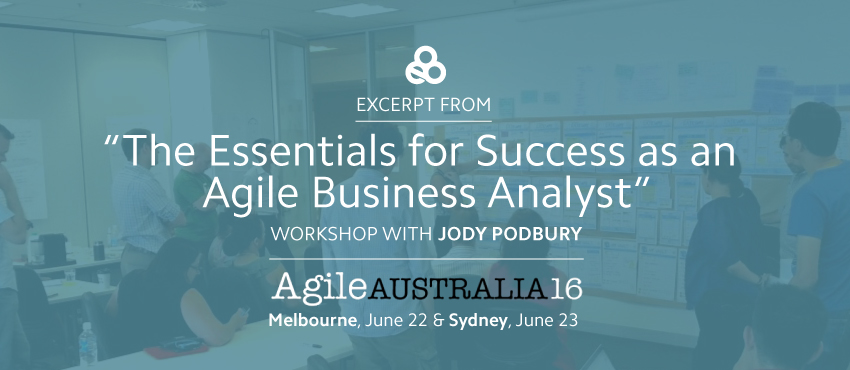You may or may not have noticed but Agile has been around a long time, longer than a decade, where did all that time go? When I first started working in Agile the biggest challenge for Business Analyst practitioners was understanding what a story was, what made a good story and what about the volumes of documents I used to write – what happens to them?
This is an overview of some elements we’ll be exploring in my workshop at Agile Australia 2016.
Taking place in Melbourne on June 22nd and in Sydney on June 23rd.
The challenge
Agile has evolved through the last decade and a half, so too has the role of a Business Analyst in an Agile team. Whilst stories are still the basic foundations of great business analysis there are more skills and practices that can make you more effective with Agile as it is practiced today. The workshop will show you additional ways you can add value to the teams you work in and give you techniques you can apply at the same time.
Perspectives and perceptions
Every team is made up of many people and when you add the stakeholders and other people and customers in the organisation that make up the ecosystem the team needs to work in, that is generally a really big number. The reality is no two people actually have the same perspective or perception on any thought or idea without some distillation.
How do you effectively create a shared context or objective amongst the myriad of perspectives and perceptions?
- Establish that different perspectives and perceptions exist
- Share them and allow them to co-exist, melt, meld and break and reform
- Create a shared or unified perspective and objective
There are many established ways of creating shared perspective at the kick-off of a project or delivery cycle but what about after we have started, and before we have come to the end?
Mid journey reset
When undertaking a project or delivery cycle no two people have the exact same experience. Our views are reshaped by the conversations we have, the things we see and do and the problems we take part in solving along the way. Our well established shared context at the kick-off is often shaken. Ever heard the term herding cats?
Taking the time to do some mid-journey check-in on those perceptions and perspectives and how they have shifted can help you recalibrate the team and realign them and get everyone moving in the same direction again.
Yes, the various flavours of Agile allows you to do this in the small increments but sometimes you need to check in on the BIG PICTURE context. Business Analysts often have the broadest relationship set within a team and outside a team into the stakeholders and are well placed to recognise and be the catalyst for these resets.
In the workshop I will introduce some techniques you can use to recreate shared context with appropriate groups on long projects or delivery cycles.
Are we there yet?
You have all heard the cry on a long journey. When we are mid project or on a long delivery cycle do we ask it enough? Do we even ask it at all?
We start a project/delivery journey with a great idea of where the “end” is. We might start off thinking in terms of value and objectives but we can get caught up in the what we are delivering and … oops we start to define the end by what we have done, rather than in terms of value and outcomes.
Should we stop, should we change direction, should we keep going?
In the workshop we will explore:
- When and how often should we ask are we there yet?
- When and how often should we ask are we still going to the right place?
- What are ways to ask that question and have confidence your answer is good?
- Are we still going somewhere valuable – how do we know that?

